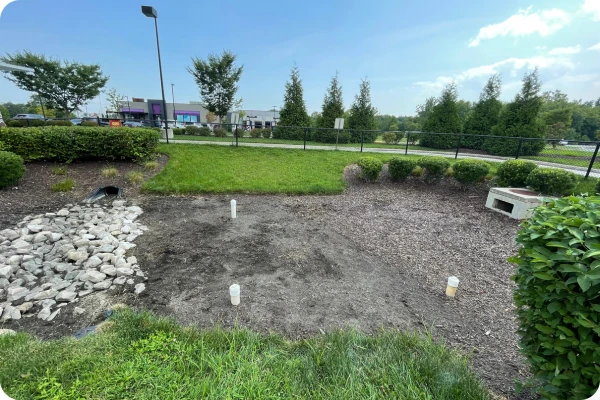As urban areas expand, managing stormwater effectively has become more critical than ever. Solutions like rain gardens, bioswales, dry swales, stormwater planters, and biofilters are transforming how we handle runoff, mitigate flooding, and enhance urban ecosystems. In this post, we dive into the benefits, advanced applications, and design considerations of these green infrastructure systems, with a focus on bioretention.
What Are Bioretention Systems and Related Solutions?
Bioretention systems, including rain gardens, bioswales, and biofilters, are designed to manage and treat stormwater runoff. These systems use soil, plants, and microbes to capture pollutants, reduce peak runoff flows, and support healthier watersheds.
- Rain Gardens: Shallow, vegetated depressions that collect and treat stormwater from rooftops, driveways, and other impervious surfaces.
- Bioswales and Dry Swales: Linear systems that direct and filter stormwater along streets or parking lots, ideal for narrow spaces.
- Stormwater Planters: Engineered containers with vegetation that manage runoff in tight urban areas.
- Biofilters: Advanced systems that use specialized soil media and vegetation to remove pollutants from stormwater.
Each of these systems contributes to a sustainable urban landscape by improving water quality and mitigating flooding.
Why Are Rain Gardens and Bioretention Systems Essential?
These systems offer multiple benefits, making them a cornerstone of green infrastructure:
1. Pollution Control
Rain gardens, bioswales, and biofilters trap contaminants like sediment, oil, and nutrients before they enter waterways, protecting aquatic ecosystems.
2. Flood Mitigation
By capturing and infiltrating stormwater, bioretention systems reduce the risk of localized flooding, a growing concern in dense urban areas.
3. Ecosystem Restoration
Green infrastructure, such as stormwater planters and dry swales, supports native plants and wildlife, creating thriving ecosystems in urban settings.
4. Groundwater Recharge
These systems allow stormwater to percolate into the ground, replenishing local aquifers and reducing the demand on municipal water supplies.
5. Urban Heat Island Mitigation
Vegetated systems like bioswales and rain gardens help cool urban areas by adding greenery and improving air quality.
Advanced Applications of Bioretention and Related Systems
Beyond stormwater management, these systems contribute to sustainable urban design in innovative ways:
1. Multifunctional Landscapes
Rain gardens and stormwater planters can double as decorative landscaping, blending functionality with aesthetic appeal.
2. Streetscape Enhancements
Bioswales and dry swales are often integrated into streetscapes to manage runoff while improving walkability and urban aesthetics.
3. Water Reuse Integration
Some biofilters and stormwater planters are designed to capture runoff for irrigation or other non-potable uses, reducing water consumption.
Designing Effective Bioretention Systems and Rain Gardens
Creating a successful system requires careful planning and attention to detail. Key design considerations include:
1. Sizing and Placement
Rain gardens, bioswales, and dry swales should be strategically located to intercept runoff from impervious areas. Proper sizing ensures they can handle expected stormwater volumes.
2. Soil and Plant Selection
The right soil mix and vegetation are essential for filtering pollutants and supporting infiltration. Native plants are ideal for their resilience and low maintenance needs.
3. Pretreatment Features
Adding sediment forebays or similar features extends the life of systems like biofilters and stormwater planters by reducing clogging risks.
4. Maintenance Access
Ensure systems are accessible for routine maintenance, such as debris removal and replanting.
Maintaining Bioretention Systems and Green Infrastructure
Regular maintenance is crucial to keeping rain gardens, bioswales, and similar systems performing at their best. Key tasks include:
- Seasonal Inspections: Check for erosion, sediment buildup, and plant health.
- Sediment and Debris Removal: Clear sediment and litter to maintain infiltration capacity.
- Replanting, Mulching, and Weeding: Replace invasive or damaged plants with suitable native species.
- Soil Testing: Periodically test soil to ensure proper infiltration and pollutant removal.
Community and Economic Benefits of Bioretention Systems
In addition to their environmental advantages, rain gardens and bioswales enhance urban spaces, boost property values, and create opportunities for community education on sustainability. These systems also reduce long-term costs associated with flood damage and water treatment.
Embracing Green Infrastructure
Rain gardens, bioswales, dry swales, stormwater planters, and biofilters exemplify how nature-inspired solutions can address complex urban challenges. These systems not only manage runoff effectively but also contribute to greener, more resilient cities. Whether you’re managing a commercial property, planning a residential development, or upgrading municipal infrastructure, investing in bioretention is a smart, sustainable choice.
Looking to integrate bioretention or similar systems into your stormwater strategy? Contact iSTORMWATER at (410) 231-3455 or contact us online today to learn how we can help.
Bioretention Frequently Asked Questions (FAQs)
What types of pollutants can bioretention systems remove?
Bioretention systems effectively remove pollutants like sediment, phosphorus, nitrogen, oil, grease, and heavy metals.
How much stormwater can a bioretention system handle?
The capacity of a bioretention system depends on its size, soil media, and design, but they are typically sized to treat the first inch of rainfall from contributing impervious areas.
Can bioretention systems be retrofitted into existing developments?
Yes, bioretention systems can be integrated into existing landscapes, often replacing underperforming traditional infrastructure.
Real Results
iStormwater LLC was an excellent choice. They made the process of the Stormwater pond repairs seamless. They took charge of the project and got the project approved and passing the inspection. We highly recommend them and would use them again.
Incredible stormwater management service. The owner John consulted on a property I manage and ended up saving us thousands of dollars in environmental fees from the government. Now, our property is compliant with the EPA and we have a great partner to keep us maintained on stormwater regulations over time.
So helpful with all of my water issues.
Great communication and leadership and a family friendly atmosphere. Thank you John!
As urban development expands, managing stormwater runoff becomes increasingly important to protect water quality, reduce flooding, and prevent erosion. One proven low-impact development (LID) solution...
- Annapolis
- Anne Arundel County
- Baltimore County
- Baltimore
- Bel Air South
- Bethesda
- Bowie
- Cecil County
- Charles County
- Columbia
- Gaithersburg
- Glen Burnie
- Howard County
- Montgomery County
- Pasadena
- Prince George’s County
- Rockville
- Severna Park
- St. Mary’s County



